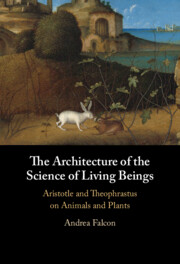Book contents
- The Architecture of the Science of Living Beings
- The Architecture of the Science of Living Beings
- Copyright page
- Dedication
- Contents
- Tables
- Acknowledgments
- Conventions
- Transliterations
- Abbreviations
- Introduction
- Chapter 1 Aristotle’s De anima and the Study of Perishable Living Beings
- Chapter 2 Aristotle’s Parva naturalia and the Study of Animals and Everything That Has Life
- Chapter 3 Pre-explanatory and Explanatory Strategies in Aristotle’s Study of Animals
- Chapter 4 The Transition from the Study of Animals to the Study of Plants (History of Plants I)
- Chapter 5 Theophrastus on the Generation of Plants (Causes of Plants I)
- Chapter 6 The Invention of Biology?
- Book part
- References
- Index of Passages
- General Index
- References
References
Published online by Cambridge University Press: 30 May 2024
- The Architecture of the Science of Living Beings
- The Architecture of the Science of Living Beings
- Copyright page
- Dedication
- Contents
- Tables
- Acknowledgments
- Conventions
- Transliterations
- Abbreviations
- Introduction
- Chapter 1 Aristotle’s De anima and the Study of Perishable Living Beings
- Chapter 2 Aristotle’s Parva naturalia and the Study of Animals and Everything That Has Life
- Chapter 3 Pre-explanatory and Explanatory Strategies in Aristotle’s Study of Animals
- Chapter 4 The Transition from the Study of Animals to the Study of Plants (History of Plants I)
- Chapter 5 Theophrastus on the Generation of Plants (Causes of Plants I)
- Chapter 6 The Invention of Biology?
- Book part
- References
- Index of Passages
- General Index
- References
Summary
- Type
- Chapter
- Information
- The Architecture of the Science of Living BeingsAristotle and Theophrastus on Animals and Plants, pp. 230 - 246Publisher: Cambridge University PressPrint publication year: 2024
- Creative Commons
- This content is Open Access and distributed under the terms of the Creative Commons Attribution licence CC-BY-NC-ND 4.0 https://creativecommons.org/cclicenses/

